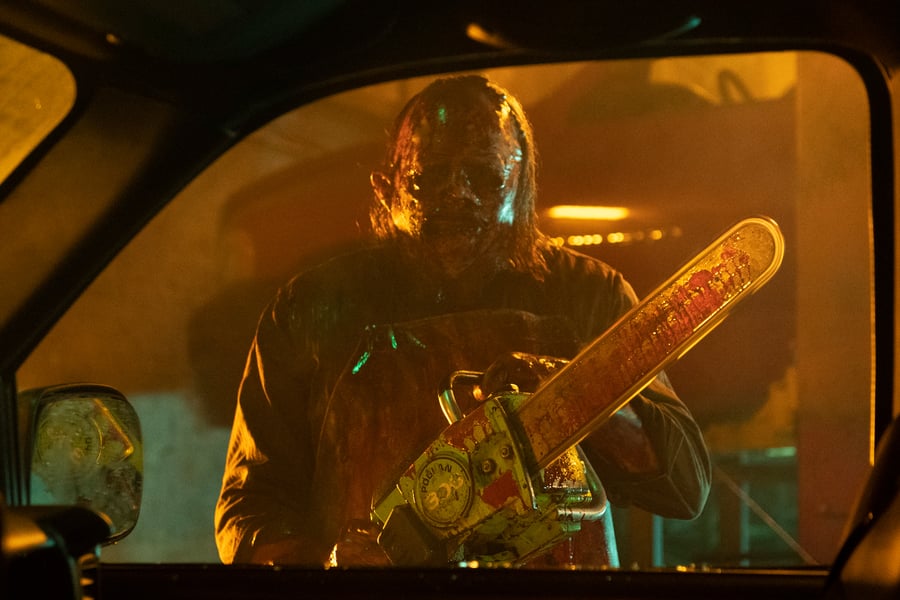There’s a very important message embedded in this brand new, fresh-off-the-chopping-block version of Texas Chainsaw Massacre, and it’s one that should be carved crudely in stone with whatever sharp instrument you have on hand, mechanized or otherwise. It’s not that hipsters should ixnay gentrifying ghost towns in the dustier corners of the Lone Star state, even if one of them is a celebrity chef and their idea of revitalizing a long-abandoned main street with a hoity-toity bistro will attract tourists. It’s not that you should hold off offending the redneck you meet in a gas station even if you think his big ol’ pickup truck is a form of overcompensation, as he may end up being an ally to you later on. It’s not that you should always make sure you have your facts straight when you’re kicking an old lady out of the orphanage she’s run for decades, as she may have never actually signed over the property. Her heart may not be able to take the strain, and should anything happen to her, it might upset the conspicuously hulking presence she keeps referring to as her “last boy.”
It’s not that you should always keep a chainsaw hidden in your bedroom wall, should you potentially need to use it on some pesky twentysomethings in the near future. It’s not that the best masks can be made from the skin of a recently deceived loved one. It’s not even “We came, we chainsawed, we conquered.”
No, the message is something that’s been abundantly clear for a good long while, and that this latest corpse-humping of Tobe Hooper’s 1974 gritty, grotty, proto-slasher nightmare proves, beyond a shadow of a doubt, needs to now be treated as common sense. It is this: Leave. Classic. Horror. Movies. Alone.
Stop remaking them. Stop giving them endless, belated sequels, or prequels, or “requels.” Stop ginning up weak origin stories for the boogeymen at the center of them. Stop slapping “a new beginning” or “the next generation” after the title — every era of teenagers may deserve to get their own encounters with hall-of-fame screen killers, but simply using fresh blood as a fresh coat of paint on a vintage title without adding anything to the proceedings is unimaginative. Stop bringing back old stars for easy in-jokes and cameos; for every ingenious revisiting of longtime final girls and famous gore-cinema lunatics a la David Gordon Green’s 2018 Halloween, there are dozens upon dozens of examples where trotting out the recognizable faces of yesteryear registers as empty fan-service gestures. (And even Green’s revitalized series couldn’t sustain its momentum.)
Stop thinking that by referencing other classic horror movies in addition to the legacy you’re already pilfering somehow makes you clever. (You’ll spot “homages” to The Shining, Halloween ’78 and a few other staples of a youth spent in video stores and conventions.) Stop exploiting fandom, nostalgia and brand recognition for your lazy, piss-poor attempts to make a name for yourself on the backs of your genre ancestors. Stop draining the canon for every ounce of Caro syrup that it’s worth.
I was reluctant to even write anything about director David Blue Garcia’s take on the tale of a man and his Black & Decker best friend, as merely mentioning that there is a new Texas Chainsaw Massacre out there in the world might draw some curious viewers or completists to it, and we would not wish that on anyone. But if we can try to treat this monstrosity as something close to a teachable moment, it may not be a total loss. Even before the franchise über alles era of moviemaking we currently live in, horror has always been highly susceptible to being sequelized and spun out to death, picking every chunk of meat off the bones of Freddy, Jason, Michael Myers, et al. even if it meant perpetually resurrecting them or sending them to space. Slap a number or a subtitle after a fan-favorite series — never mind if the story is ridiculous, the kills uninspired, the execution insultingly sloppy and slapdash — if we build it, they will come. That’s the mentality.
And while The Texas Chainsaw Massacre predates the slasher boom, its grunting, guts-flecked central figure has suffered the same indignities that his genre brethren has. For some reason — maybe it’s because the seminal, ’74 original holds such a special place in so many die-hards’ hearts (this one included), and still feels like such a potent example of channeling primal fear — this latest ransacking of a landmark title feels less like just another killer-versus-final-girl rerun and more like the final straw. No more. For the love of Leatherface, leave this massacre alone once and for all. It’s time to put the chainsaw down and walk away.
Love Music?
Get your daily dose of everything happening in Australian/New Zealand music and globally.
From Rolling Stone US



































